Beyond the Border, Beyond Belief

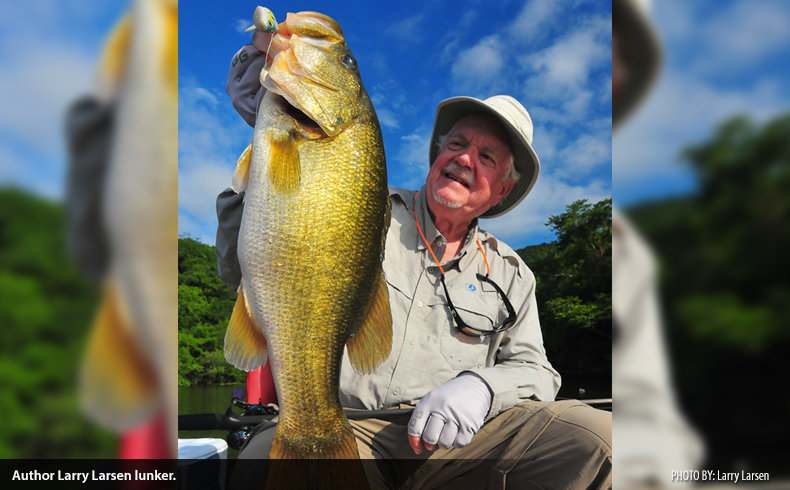
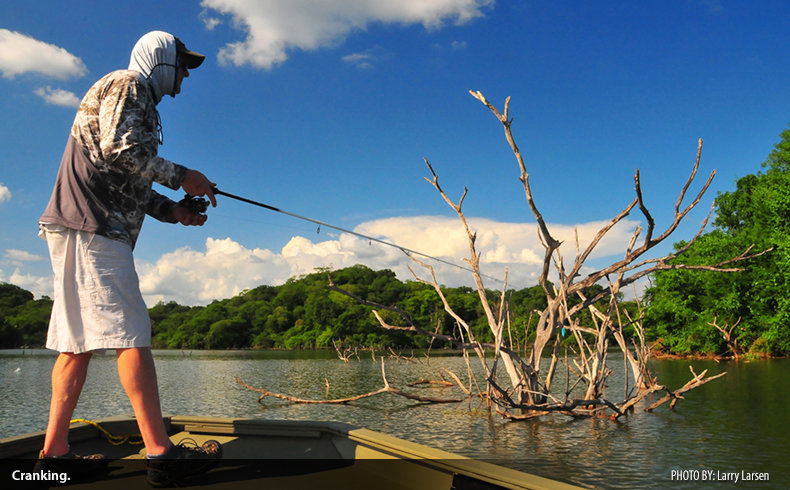
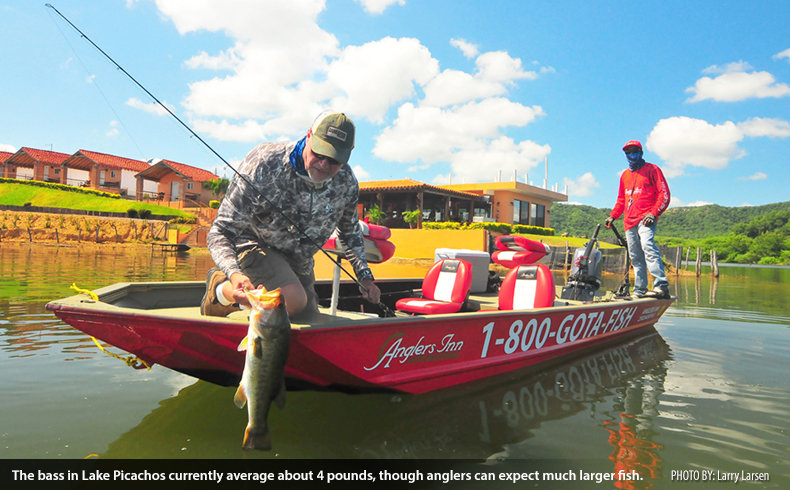


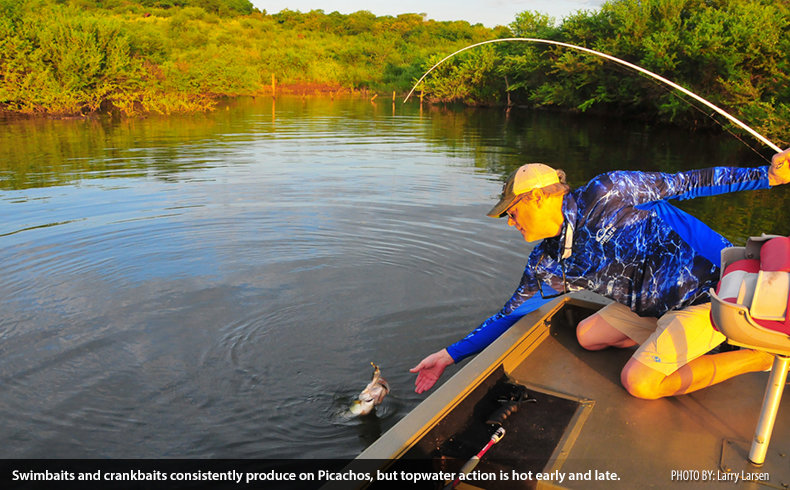
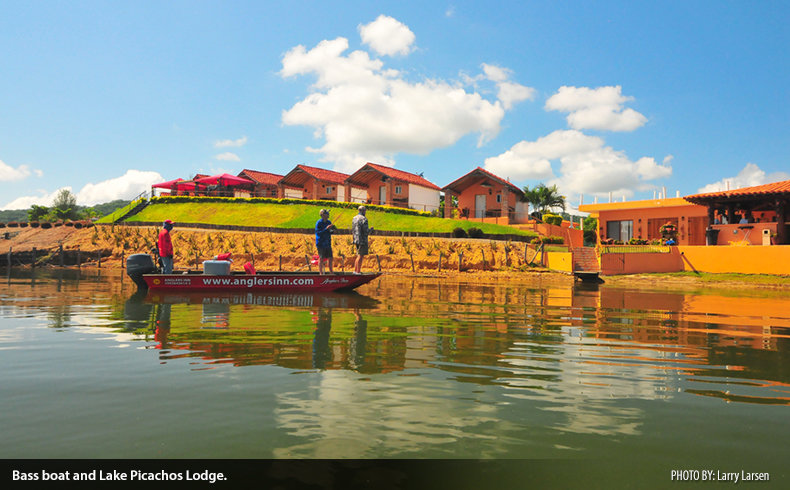
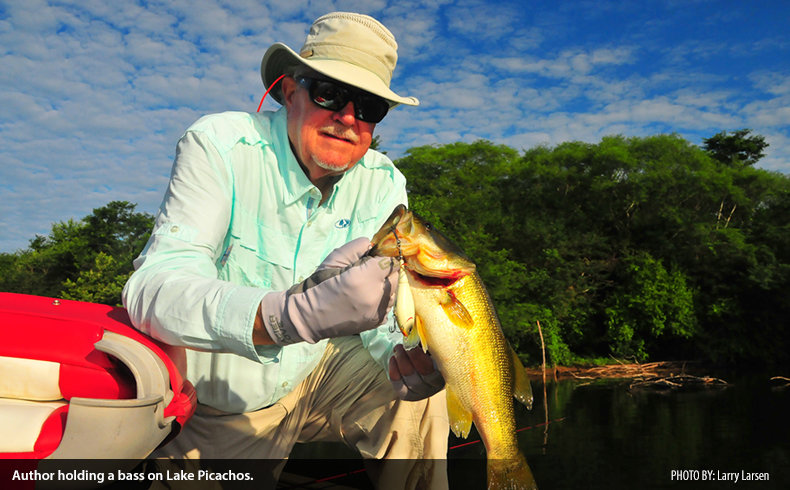





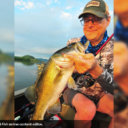





By Larry Larsen
Article Published in the Game & Fish Magazine November 2020 issue.
Mexico’s Lake Picachos is so full of hefty largemouths that catching 300 pounds or more of bass in a single day is not out of the question.
For bass fishermen, the call of Mexican waters has been loud and clear for many years. Reputations of 100-fish days and average weights exceeding those touted by 90 percent of bass fisheries in the United States are difficult to ignore. Almost everyone with a closet full of tackle would forego the bass populations in 49 states for a shot at one of the hottest largemouth lakes in the world.
The name of the best Mexican bass lake varies every 10 years or so, but there are always two or three that command current attention. Often the hottest lake will be a relatively new reservoir in or very near the western Sierra Madre Mountains. During the past 45 years, a dozen or more impoundments scattered around the vast mountain range stretching from the U.S./Mexico border south to Mexico City have made their marks on finely focused bass minds and claimed places in anglers’ hearts.
Today, there are about two dozen reservoirs along the Sierra Madre; three-quarters of them are on the western side of the range. Most of the steeper gradients with substantial rivers drain to the west into the Pacific Ocean, and that’s why the Mexican government has created more reservoirs on that side.
In a typical new manmade lake in Mexico, there is a bass growth rate of 1 ½ to 2 pounds per year. One of the main factors in such productivity is that Mexican authorities don’t clear or cut down existing jungle when developing an impoundment. They just flood it. Such cover helps keep lake productivity up for years until the wood eventually deteriorates. When a lake is fertile like that and has been stocked with Florida-strain largemouths, in a far south location where the growing season is longer, it will become a great fishery. A booming reservoir may stay hot for 12 to 18 years.
Perhaps the hottest current prospect yielding 100-plus largemouths per day (or sometimes per half day) per boat, is the beautiful Lake Picachos near Mazatlan in west-central Mexico. These waters are the most accessible in western Mexico for Americans wanting a short direct flight from an U.S. airport. It takes less than an hour to drive from Mazatlan International Airport to Picachos. Despite the proximity to the city, local fishermen primarily fish the massive 18,000-acre lake only on long holidays. The lake seldom sees any real fishing pressure, and there may be only two or three dozen sportfishing boats spread out around the impoundment on the busiest of days.
Lake Picachos was flooded and stocked with Florida largemouth bass around 10 years ago, and today, it regularly produces 6-, 7- and 8-pounders. The lake record is already 12 pounds, 4 ounces, according to Anglers Inn Lake Picachos lodge owner Billy Chapman Jr., who’s finishing up his sixth season there. An 11-pound, 6-ounce bass was taken by one of his clients on a fly in February 2018. Some locals have reported bass up to 14 pounds, according to Jose Cruz Rincon, the service operations manager at the lodge. The average group of anglers fishing three or four days normally catches several 6- to 9- pounders per trip.
Testing Picachos
While I’ve fished six or seven Mexico bass lakes in their prime over the past 40 years, I hadn’t checked out Picachos until this past fall. Several Game & Fish editors and contributors ventured to the lake for the annual Game & Fish Tackle Test, a thorough on-the-water evaluation of nearly 50 rods and reels from numerous companies. We needed lots of action and opportunity during our three days on the lake to properly assess the products, and Picachos did not let us down.
Our group of anglers was the first to visit the lake after the typical August to September closure. The lodge takes a break during that period; rainy months, the year’s greatest water-level rise and hottest air temperatures, plus the tilapia spawning season can all make the fishing a bit tough. The guides, who hadn’t fished Picachos for two months, were trying to relocate the bass and develop a productive pattern for the high-water conditions.
Our first two days might be considered a little slow for a hot lake. My partner Scott Bernarde, Game & Fish online content editor, and I “only” caught around 120 largemouths. Our largest bass was a 7-pound-plus fish that fell for my Berkley Swim Shad cast into a flooded graveyard. The big bass holding in the inundated Las Iguanas Cemetery slammed the 1-ounce swimbait and headed for a couple of gravestones that extended about 3 feet above the surface. I snubbed the fish but worried that it might run around another tombstone on the bottom.
The fat female made another turn, pulled drag and jumped out of the water once, and then again, with my swimbait waving as she shook her head violently. Fortunately, the single hook held and the fish circled back around the boat without hanging up on anything. My guide Oscar Osuna got the net in front of her, and the chaos was over. After a photo, I quickly released the bass.
My third-day results were more indicative of a hot lake’s typical action. Fishing by myself that morning, I cast a 3-inch, 7/8-ounce Berkley Dredger 20.5 crankbait to a rocky point with a few limbs at 15- to 20-foot depths and caught a 4-pounder. Then I repeated the scenario seven more times in succession on bass averaging around 3 ½ pounds each. My eight-fish streak ended with a missed strike followed by another cast without a strike, but it didn’t take long to recover. I made 22 casts without moving the boat and caught 18 bass before the action slowed some.
A strike every other cast or so is still a barrel of fun. In all, I caught 45 largemouths that ranged from 3 to 4 ½ pounds in just 45 minutes on that productive point. My guide used his bass-tally clicker and scored each one landed. I had to take a photo of the final fish and Oscar with his clicker to record the achievement. That kind of action is rarely encountered anywhere else. We then changed locations, and I caught another 12 bass before heading in for lunch and a relaxing siesta at 11 a.m.
Changing Lake Patterns and Tactics
Lake Picachos’ maximum depth is 250 feet. The average ranges from 40 to 60 feet, and there are a lot of flooded trees at those depths in most areas. The reservoir is fed by the Rio Presidio and several small arroyos (gully streams) including the San Marcos, Callejar, Acaponete and Del Pincel. July through September is the rainy season at Picachos, and the fast-growing vegetation on the shores and in the hills turns the landscape green. With the influx of rainwater, there is a 40-foot difference between the lake’s high- and low-water levels.
Some of the small towns inundated and relocated prior to the filling of the impoundment include San Marcos, Las Iguanas and La Puerta. Many of the guides and most of the 50 or 60 commercial tilapia fishermen that regularly work their nets live in those towns. Like on most Mexican impoundments, local tilapia netters fish Picachos under quotas, and sport fishermen have to deal with hang-ups. Restrictions mandate that nets be in place for no more than 10 consecutive days, and then the fishermen must remove them from the water for five days to rest the lake. Commercial fishermen cease netting in June, restock the lake with tilapia and resume fishing in October.
Lake Picachos is normally full in October. The weather is warm, but the bass are active and relatively deep as we found out. The best topwater fishing is early in the morning and late in the evening. Anglers typically employ soft-plastic baits, swimbaits and crankbaits in deep water between 9 a.m. and 5 p.m.
In November and December, the weather starts changing and the fish move shallower. Anglers get a lot more topwater action, and most boats will be fishing in 10 to 15 feet of water during high-sun times. Worms almost always produce in deeper areas then. The dry season extends from November through June, and this brings the highest numbers of bass caught per day and the best topwater action of the year. Anglers will often catch 100 fish per day; the lake record for one boat with two anglers is 402 largemouths caught and released in 10 hours!
January is pre-spawn time. Again, topwater action occurs early and late, and the remainder of the day finds anglers fishing deeper with a swimbait, crankbait or plastic worm. You may need a jacket in the winter months. In February and March, the Florida-strain bass are spawning, so fishing for giants can be hit or miss. Chances of catching up to 100 male bass per day per boat, though, are excellent.
In April after spawning, the bass rest for a week or two, and the bite may be slower. A crankbait or swimbait will be effective on deeper fish in up to 30 feet of water. This period through June is very good for big, fat bass.
The productive pattern of big bass on 5- or 6-inch swimbaits remains the same during May, June and July. Allow the swimbait to fall five to 10 seconds before making a slow, steady retrieve. Deep-running crankbaits are also responsible for catching a lot of big bass on Picachos in waters 5- to 20-feet deep, especially during the hotter months. Ones that resemble the primary forage of threadfin shad, small tilapia or crayfish, and are retrieved to occasionally bump the rocky bottom or a submerged log, attract the most strikes.
Relax… but not too long
In Mexico it’s necessary to seek refuge from the high-noon sun, and the accommodations on a literally hot lake are important. A visiting angler will usually spend about four hours in the middle of the day having lunch and a siesta, sometimes called a power nap, to recharge the body.
Anglers Inn is one of two international operations on the lake. Jose Rincon has been the service operations manager since the lodge opened more than five years ago, transferring from Billy Chapman Jr.’s nearby Anglers Inn on Lake El Salto after 20 years in management there.
Each morning, anglers are awakened and greeted by Jose with coffee and juice prior to sunrise. After a hearty breakfast, they head toward a breathtaking dawn spilling from behind the uniquely pattered Sierra Madre peaks. During our visit in October, the lake areas were clear, but waves of fog were sleeping in the valleys of the surrounding mountains. The awesome sunrise that welcomes visitors to a gorgeous day is a dessert for the senses served daily on this lake.
Anglers fish from 5:30 or 6 a.m. to about 11 a.m., and then come in to escape the midday heat and enjoy a scrumptious hot lunch that rivals most dinners at other lodges. Afterwards, most anglers retreat to their air-conditioned cabins for a much-needed siesta. Don’t oversleep, however, because you’ll need to go back out around 3 p.m. and fish until almost 8. There could be 100 more bass waiting to bite!
Lake Picachos Trip Planner
Tear yourself from the fishing to enjoy nearby Mazatlan.
Anglers Inn Lake Picachos is a comfortable lakeshore resort that currently accommodates up to 20 anglers in 10 air-conditioned rooms. The service is unexcelled. From the welcome margarita to the final morning’s breakfast, guests are treated like kings. The lodge’s waterfront restaurant and bar with beautiful views of the Sierra Madre Mountains are located on a point. Huge glass windows allow patrons to watch the sun rise and set over the lake each day.
The food is outstanding. Appetizers of quesadillas, nachos or beef burritos are followed by filet mignon, langostinos (huge river prawns), lobster and ribs. Fancy desserts (as well as good ol’ banana splits) treat your tastebuds. There’s bottled water and plenty of adult beverages. Amenities include a massage service, laundry service, satellite TV and Internet so that you can check your email, if you must, when not on the water.
The lodge has a small tackle shop and rental tackle packages of rods, reels and lures. The 17-foot Tracker bass boats are equipped with 60-horsepower Yamaha outboards and MinnKota trolling motors. Three- and four-day fishing packages that include guide, boat, food and accommodations are offered year-round except the rainy months of August and September, when Anglers Inn Lake Picachos is closed.
Visitors to Lake Picachos may want to spend a day or two in nearby Mazatlan, known as the “City of Sails” because of the abundance of the popular sportfish in the nearby Pacific. World-class billfishing is surprisingly affordable with rates about half of what you might pay in the states. Mazatlan’s best deep-water drops, including the Gangas Canyon, lie about 20 miles offshore, where the bottom goes from 300 feet down 600 feet or more. Pacific sailfish ranging from 60 to 90 pounds are common from May through November . Offshore charter boats from El Cid and two other area marinas may catch 10 to 15 per boat in May through July.
Mazatlan is also attractive because of its laid-back charm and quaint seaside ambiance. You won’t find the hustle of Cancun or other tourist destinations in this fishing village settled by the Spaniards in the early 1500s. There are 10 miles of sandy beaches, and nice hotels in the “Golden Zone” offer the sound of a rolling surf to lull you to sleep at night. American Airlines flies direct to Mazatlan from Dallas and Phoenix.